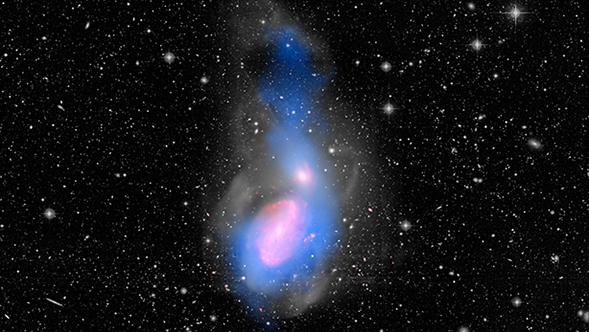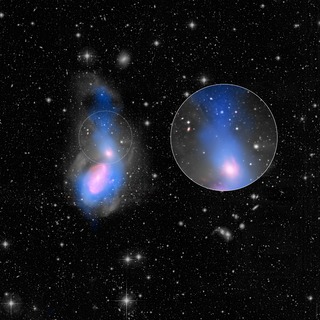
News Release • December 5th, 2014 • feature14-22 •
Some like it hot, but for creating new stars, a cool cosmic environment is ideal. As a new study suggests, a surge of warm gas into a nearby galaxy -- left over from the devouring of a separate galaxy -- has extinguished star formation by agitating the available chilled gas.
The unique findings illustrate a new dimension to galaxy evolution, and come courtesy of the European Space Agency's Herschel space observatory, in which NASA played a key role, and NASA's Spitzer and Hubble space telescopes.
Astronomers want to understand why galaxies in the local universe fall into two major categories: younger, star-forming spirals (like our own Milky Way), and older ellipticals, in which fresh star making has ceased. The new study's galaxy, NGC 3226, occupies a transitional middle ground, so getting a bead on its star formation is critical.
"We have explored the fantastic potential of big data archives from NASA's Hubble, Spitzer and ESA's Herschel observatory to pull together a picture of an elliptical galaxy that has undergone huge changes in its recent past due to violent collisions with its neighbors," said Philip Appleton, project scientist for the NASA Herschel Science Center at the California Institute of Technology in Pasadena and lead author of a recent Astrophysical Journal paper detailing the results. "These collisions are modifying not only its structure and color, but also the condition of the gas that resides in it, making it hard -- at the moment -- for the galaxy to form many stars."
NGC 3226 is relatively close, just 50 million light-years away. Several star-studded, gassy loops emanate from NGC 3226. Filaments also run out from it and between a companion galaxy, NGC 3227. These streamers of material suggest that a third galaxy probably existed there until recently -- that is, until NGC 3226 cannibalized it, strewing pieces of the shredded galaxy all over the area.
A prominent piece of these messy leftovers stretches 100,000 light-years and extends right into the core of NGC 3226. This long tail ends as a curved plume in a disk of warm hydrogen gas and a ring of dust. Contents of the tail, thought to be the debris from that departed galaxy, are falling into NGC 3226, drawn by its gravity.
In many instances, adding material to galaxies in this manner rejuvenates them, triggering new rounds of star birth thanks to gas and dust gelling together. Yet data from the three telescopes agree that NGC 3226 has a very low rate of star formation. It appears that in this case, the material falling into NGC 3226 is heating up as it collides with other galactic gas and dust, quenching star formation instead of fueling it.
The outcome could have been different, as NGC 3226 hosts a supermassive black hole at its center. The influx of gas and dust might have ended up just feeding the black hole, setting off energetic outpourings as the material crashed together while whirling toward its doom. Instead, the black hole in NGC 3226's core is just snacking, not gorging, as the material has spread out in the galaxy's central regions.
"We are discovering that gas does not simply funnel down into the center of a galaxy and feed the supermassive black hole known to be lurking there," Appleton said. "Rather, it gets hung up in a warm disk, shutting down star formation and probably frustrating the black hole's growth by being too turbulent at this point in time."
NGC 3226 is considered something between a youthful "blue" galaxy and an old "red" galaxy. The colors refer to the predominantly galactic blue light radiated by giant, young stars -- a telltale sign of recent star formation -- and the reddish light cast by mature stars in the absence of new, blue ones.
This intermediary galaxy illuminates how galaxies accruing fresh gas and dust can bloom with new stars or have their stellar factories close shop, at least temporarily. After all, as the warm gas flooding NGC 3226 cools to star-forming temperatures, the galaxy should get a second wind.
Intriguingly, ultraviolet and optical light observations suggest that NGC 3226 may have produced more stars in the past, leading to its current intermediate color, somewhere between red and blue. The new study indicates that those traces of youth must indeed be lingering from higher levels of star formation, before the infalling gas scrambled the scene.
"NGC 3226 will continue to evolve and may hatch abundant new stars in the future," said Appleton. "We're learning that the transition from young- to old-looking galaxies is not a one-way, but a two-way street."
Other authors of the report are: C. Mundell of Liverpool John Moores University, England; M. Lacy of National Radio Astronomy Observatory, Charlottesville, Virginia; V. Charmandaris of University of Creete, Greece; P-A. Duc of CEA-Saclay, France; U. Lisenfeld of University of Granda, Spain; and T. Bitsakis, K. Alatalo, L. Armus and P. Ogle of Caltech.
Herschel is a European Space Agency mission, with science instruments provided by consortia of European institutes and with important participation by NASA. While the observatory stopped making science observations in April 2013, after running out of liquid coolant, as expected, scientists continue to analyze its data. NASA's Herschel Project Office is based at NASA's Jet Propulsion Laboratory, Pasadena, California. JPL contributed mission-enabling technology for two of Herschel's three science instruments. The NASA Herschel Science Center, part of the Infrared Processing and Analysis Center at Caltech, supports the U.S. astronomical community.
JPL manages the Spitzer Space Telescope mission for NASA's Science Mission Directorate, Washington. Science operations are conducted at the Spitzer Science Center at Caltech. Spacecraft operations are based at Lockheed Martin Space Systems Company, Littleton, Colorado. Data are archived at the Infrared Science Archive housed at the Infrared Processing and Analysis Center at Caltech.
Caltech manages JPL for NASA.
The Hubble Space Telescope is a project of international cooperation between NASA and the European Space Agency. NASA's Goddard Space Flight Center in Greenbelt, Maryland, manages the telescope. The Space Telescope Science Institute (STScI) in Baltimore conducts Hubble science operations. STScI is operated for NASA by the Association of Universities for Research in Astronomy, Inc., in Washington.
Fore more information about NASA's role in Herschel, visit: http://www.nasa.gov/herschel
For more information about Hubble, visit: http://www.nasa.gov/hubble





